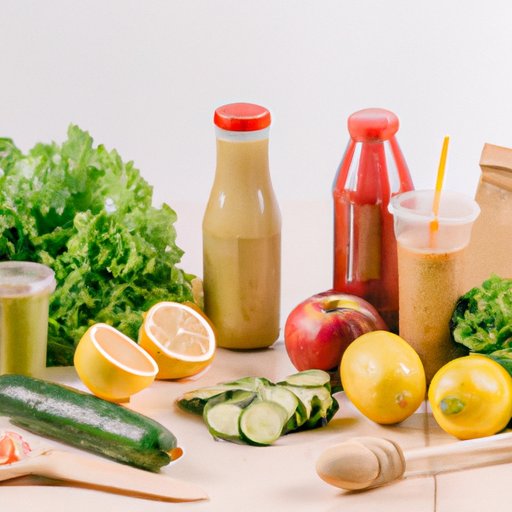
Introduction
A liquid diet is exactly what it sounds like – a diet that consists solely of fluids, rather than solid foods. People may be put on a liquid diet for various reasons, such as preparing for certain medical procedures, easing digestive issues, or managing diabetes. While it may sound daunting, a liquid diet can actually provide all the necessary nutrients for your body, as long as it’s done correctly.
Surviving on Soup: A Guide to Liquid Diets and What You Can Eat
Soups and broths are the foundation of many liquid diets. They are easy to digest, provide hydration, and can be packed with nutrients.
When making soups and broths for a liquid diet, it’s important to use high-quality ingredients. Opt for fresh vegetables, lean proteins, and real bone broth if possible. Use a blender or immersion blender to create a smooth consistency.
Some suggested soup and broth recipes for a liquid diet include:
- Chicken noodle soup (made with finely chopped veggies and easily digestible noodles)
- Tomato soup (made with pureed tomatoes and vegetable broth)
- Beef stew (made with lean beef, low-sodium broth, and canned vegetables)
- Lentil soup (made with lentils, vegetable broth, and pureed veggies)
Fluid Eating: Tips and Suggestions for a Successful Liquid Diet
Hydration is key when on a liquid diet. It’s recommended to consume at least 8-10 cups of fluids per day. Opt for water, herbal tea, or low-sugar sports drinks to replenish electrolytes.
It’s also important to space out your fluid intake throughout the day, rather than chugging a large amount at once. This can help prevent stomach discomfort and make sure your body is absorbing nutrients efficiently.
When it comes to liquid calories, it’s important to make the most of them. Focus on consuming nutrient-dense liquids, such as homemade fresh fruit smoothies or protein-rich vegetable soup broth.
Beyond Broth: Exploring the Wide Range of Foods You Can Consume on a Liquid Diet
There are actually many types of liquid foods that can be consumed on a liquid diet, beyond just soups and broths. Smoothies, juices, and milkshakes can all provide valuable nutrients, when made with the appropriate ingredients.
For smoothies, use fresh or frozen fruit, a liquid base such as almond milk or coconut water, and a source of protein such as Greek yogurt or nut butter. For juices, opt for fresh vegetables and low-sugar fruits. For milkshakes, use a milk or milk alternative, frozen fruit, and protein powder or nut butter.
Some suggested liquid food recipes for a liquid diet include:
- Green smoothie with spinach, banana, almond milk, and protein powder
- Carrot juice with apple, ginger, and turmeric
- Vanilla protein milkshake with almond milk, frozen banana, and vanilla protein powder
- Blueberry and avocado smoothie with almond milk and chia seeds
Elevating Your Liquid Diet: Creative and Nutritious Ideas for Sustaining Your Health
While liquid diets can be effective in the short term, it can be challenging to maintain them long term without getting bored or lacking certain nutrients.
One suggestion for incorporating protein on a liquid diet is using bone broths. They are high in protein and can be made into soups or sipped on their own. Adding herbs and spices such as turmeric or cumin can provide additional flavor and health benefits, such as reducing inflammation. Healthy fats can also be added through sources such as avocado or coconut milk.
Another way to add variety to a liquid diet is by experimenting with herbs and spices. Different combinations can add a depth of flavor to simple soups and broths. For example, adding rosemary to chicken noodle soup or ginger to tomato soup can provide a unique twist.
Liquid Diets Demystified: Understanding What’s In and What’s Out of Your Meal Plan
While liquid diets can be effective, it’s important to keep in mind what foods should be avoided. Solid foods such as bread, meat, and vegetables should be avoided, as they can cause digestive issues and be difficult to digest.
When working with a healthcare provider to determine the best liquid diet for your individual needs, consider factors such as calorie needs, protein requirements, and any allergies or sensitivities you may have.
Conclusion
A liquid diet can be an effective way to meet certain health needs, as long as it’s done correctly. By focusing on nutrient-dense liquids such as soups, smoothies, and juices, incorporating herbs and spices, and working with a healthcare provider, a liquid diet can be a sustainable and nutritious way to support your health.





